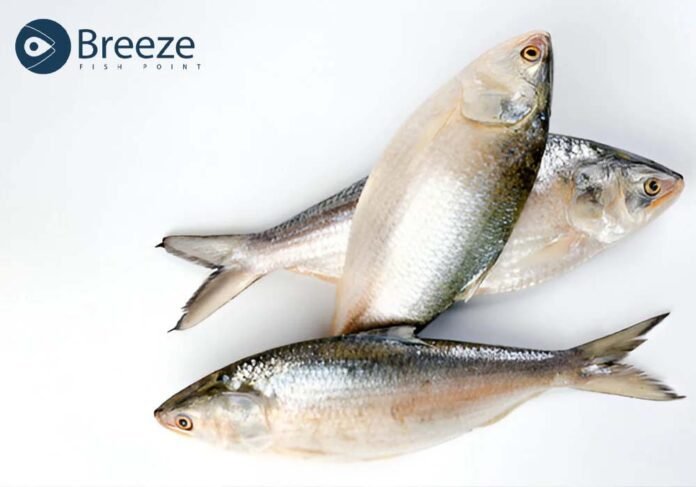Quick Information on Hilsa (Palla) Fish | Details |
Scientific Name of Hilsa | Tenualosa ilisha |
Hilsa Fish in English | Hilsa shad |
Also Known As | Palla fish in Sindh, Ilish fish, Ilsha fish, Llish fish |
Famous In | Sindh (especially Hyderabad), Bangladesh, West Bengal |
Best Season to Eat | Monsoon (June–September) |
Taste Profile | Rich, oily, soft flesh with delicate bones |
Cultural Significance | Symbol of festivity, served in weddings and celebrations |
Fun Line | “Keep reading to find out everything you need to know about the hilsa and keeping this – taste, popularity, history etc!” |
What Is Hilsa and Why Is It Called Palla Fish in Sindh?
If you’ve ever strolled through a bustling fish market in Sindh during the monsoon, you’ve probably heard one name called out more than any other — hilsa fish. In Sindh, it’s lovingly called palla fish and is regarded as a seasonal delicacy. Its scientific name is Tenualosa ilisha, but in homes and markets, it goes by many names — ilish fish, ilsha fish, llish fish, or simply hillsha fish.
Unlike ordinary river fish, hilsa thrives in both freshwater and brackish waters, migrating from the sea to rivers for spawning. This unique journey gives it a rich, melt-in-the-mouth flavor that no other fish quite matches. And yes, pompano lovers might argue for their fish, but hilsa is in a league of its own.
Why Is Hilsa So Popular in Sindh Compared to Other Regions?
In Sindh, especially in Hyderabad, hilsa or palla fish is more than just food — it’s an event. People travel from far-off cities and even other provinces just to taste the authentic Sindhi-style hilsa.
Here’s why its popularity soars:
- Seasonal Rarity – Available mainly in monsoon months.
- Cooking Traditions – Grilled whole with spices, or steamed in banana leaves.
- River Indus Quality – Palla from Indus waters is considered superior in taste.
- Cultural Connection – Served in weddings, Eid feasts, and special gatherings.
How Does Hilsa Compare to Bengali Ilish?
Aspect | Sindh (Palla Fish) | Bengal/Bangladesh (Ilish) |
Water Source | Indus River | Padma, Meghna Rivers |
Taste | Mildly sweet, rich oil | Stronger, saltier oil |
Cooking Style | Grilled or spicy curry | Mustard-based curry |
Availability | Seasonal (shorter) | Longer season in some areas |
What Is the Scientific Name of Hilsa and Why Does It Matter?
The scientific name of hilsa is Tenualosa ilisha. Knowing this is more than trivia — it connects us to the fish’s biological identity and helps in conservation studies.
Fun fact: Hilsa belongs to the herring family, which means it shares relatives with many common sea fishes, but its flavor is unique and highly prized.
What’s the English Name of Ilish Fish?
How Is Hilsa Cooked in Sindh?
In Sindh, cooking hilsa is a craft. Here are the most popular ways locals prepare it:
- Grilled Palla – Marinated with salt, red chili, and garlic, then roasted over coals.
- Palla Curry – Slow-cooked with tomatoes, onions, and green chilies.
- Steamed Hilsa – Wrapped in banana leaves with spices.
- Hilsa Biryani – Rare but indulgent, mixing river fish with fragrant rice.
Why Do People Travel to Hyderabad Just for Palla Fish?
It’s not just taste — it’s the experience.
- Fresh from the River – Often caught hours before cooking.
- Traditional Restaurants – Hyderabad boasts decades-old eateries specializing in palla.
- Family Ritual – Families make annual trips just to enjoy the seasonal feast.
- Tourist Magnet – Even international visitors seek it out.
Is Hilsa the Same Everywhere?
What’s Special About Its Taste and Texture?
- Oily Richness – Natural fish oil makes it tender and flavorful.
- Bone Structure – Fine bones require careful eating — almost part of the charm.
- Distinct Aroma – Strong but appetizing, especially when freshly cooked.
Where Else Is Hilsa Found?
Aside from Pakistan and Bangladesh, hilsa appears in:
- India (West Bengal, Odisha, Assam)
- Myanmar
- Middle Eastern seafood markets (imported)
Hilsa Cooking & Eating Tips
For First-Timers
- Eat slowly — bones are tiny and plenty.
- Try it grilled first to appreciate its flavor.
- Pair with lemon to balance the oiliness.
For Cooks
- Do not overcook — hilsa loses texture quickly.
- Keep spices light if cooking for the first time.
Freshness is key — frozen hilsa loses much of its charm.




